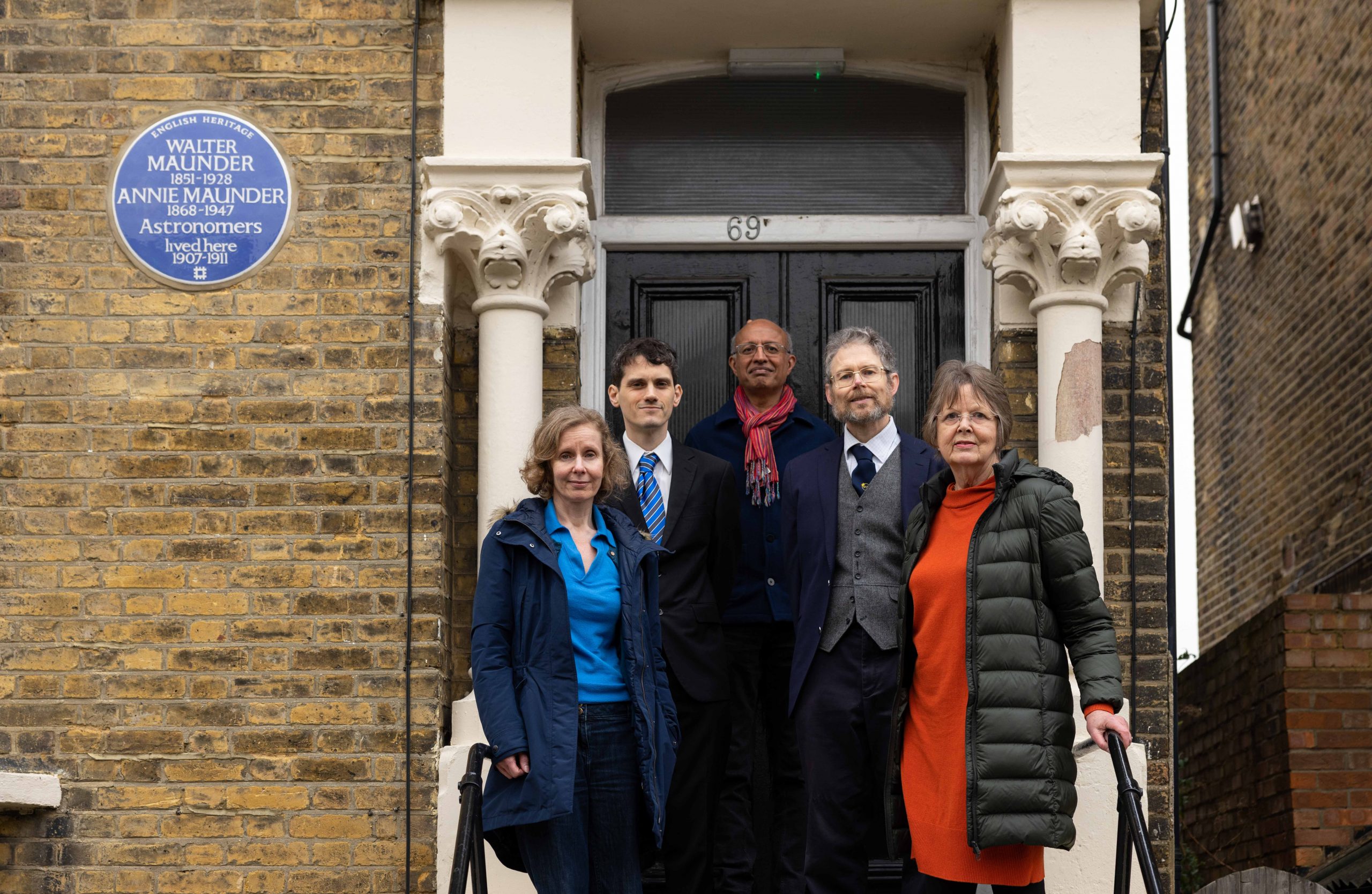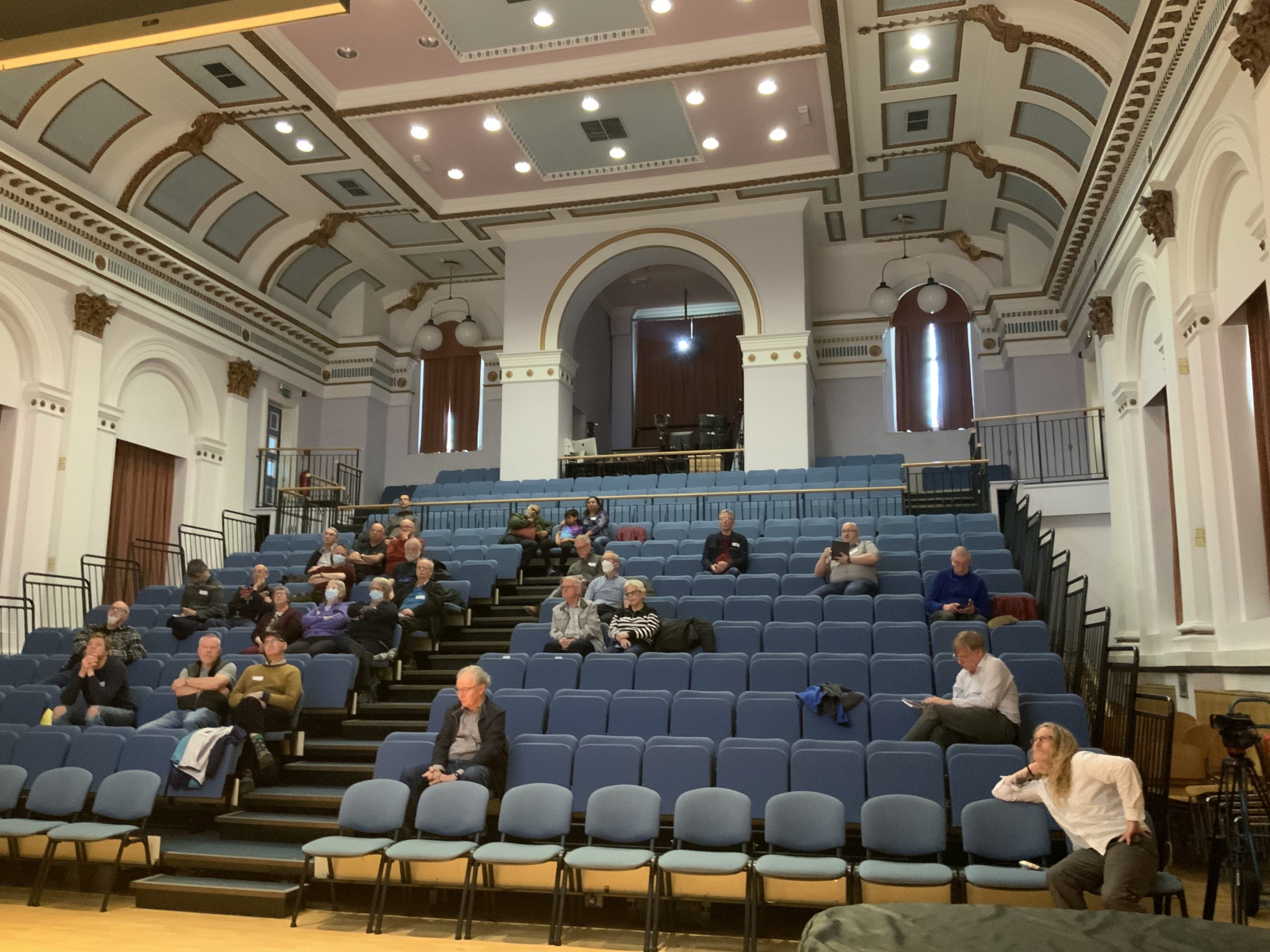From the President
2022 June 6
A plaque for the Maunders
It gave me great pleasure to represent the Association at the unveiling of an English Heritage blue plaque for two great astronomers on 2022 March 16.

Edward Walter Maunder (1851–1928) is remembered for many things, but principally for his pioneering studies of solar activity and terrestrial magnetism at the Royal Observatory, Greenwich. He was the first to clearly demonstrate a link between the two (the existence of ‘space weather’ as we now call it), discovered the sunspot latitude cycle as illustrated in the ‘butterfly diagram’, and identified a long minimum in the historical sunspot record. We remember him as the founder of the Association. Though the first proposal concerning the formation of the BAA was made by W. H. S. Monck, it was Maunder who set the practical steps in train, collecting the founding members, and organising the first meeting on 1890 October 24. He then took on the role of founding Editor of the Journal. Four years later, he became the third President, following which he served as Editor again. He was also Director of three different observing sections at different times, and Secretary of the Association.
Annie Maunder (1868–1947) was born Annie Scott Dill Russell. Excelling in mathematics at the University of Cambridge, she became in 1891 what was called a ‘lady computer’ at Greenwich and was set to work measuring the daily sunspot photographs that Walter Maunder took. He introduced her to the BAA, which she joined, and she immediately started to help in his work on the Journal, taking over as Editor from 1894–’96 while he served as President. In 1895 they married (Walter’s first wife, with whom he had six children, had died in 1888).
It is recorded that ‘Mr and Mrs Maunder gave to new members and beginners in astronomy that friendly encouragement which … is a feature of the Association. Mrs Maunder was asked several times to become President but refused on account of her voice, which would not carry in a large room.’1 (It is a pity that amplification had not been invented, or we would have had our first female President about 80 years earlier than we did.) Her mathematical ability was put to service in their joint research work, and a determination of the solar rotation period ‘that embodies some ingenious and novel statistical methods’ was published in both their names in 1905. It is clear that all Walter Maunder’s discoveries owed much to her. She accompanied him on five expeditions to view total solar eclipses, and took remarkable photographs of the solar corona on the BAA expedition to India in 1898. She edited the Journal for a second period, from 1917–’30.
The plaque on 69 Tyrwhitt Road, London SE4, home to the Maunders from 1907–’11, was proposed by Dr Nicholas Heavens, a planetary scientist with the Space Science Institute, Boulder, Colorado, who is resident in London. He spoke at the event on March 16 along with Prof Sanjeev Gupta, an Earth and planetary scientist at Imperial College who happens to live in the next street; Prof Sarah Matthews, head of solar physics at UCL’s Mullard Space Science Laboratory; and Dorrie Giles, a descendent of Walter Maunder. Several other descendants were also present (from Walter’s first marriage – Annie had no children).
English Heritage blue plaques must meet strict criteria. The people memorialised need to have been dead more than 20 years, to have lived at the property for a substantial time, and the property needs to be recognisably the same as it was then. Fortunately the house, and indeed the whole street, is almost unaltered from the time the Maunders lived there. It is gratifying that there is now this public memorial not only to the founder of the Association, but to a remarkable husband-and-wife scientific team. Craters on the Moon and Mars also commemorate the pair, while Walter has an asteroid named after him. Annie herself has another blue plaque, at her birthplace in Strabane, Northern Ireland; the RAS have an Annie Maunder Medal; and the Royal Observatory have an Annie Maunder Astrographic Telescope. If she was ever the ‘forgotten’ member of the pair, she certainly is no longer.
North & South
The BAA tries to cover the whole of the UK (and sometimes beyond) with its events. I have recently been fortunate enough to attend the Winchester Weekend (held April 8–10 for the first time since 2019, and incorporating a meeting of the Lunar Section), and our one-day Spring Meeting held in Leeds on the themes of ‘Stellar winds and planetary atmospheres’. Both were outstanding successes, thanks largely to the organisation by Ann Davies and Alan Dowdell in the first case, and Hazel Collett in collaboration with Leeds Astronomical Society in the second.

Our Summer Meeting occurs this year in Nottingham on June 25, in collaboration with Nottingham Astronomical Society. It is on the themes of ‘Cosmology, galaxies and exoplanets’. You can now book for this via the britastro.org website. Further ahead, our Autumn Weekend Meeting will be held in Elgin, Scotland on September 9–11, in collaboration with Moray’s astronomy club, SIGMA.
These events allow the BAA to foster links with both societies and academic astronomy departments across the country. We are currently looking for societies or departments who would like to host the Autumn Meeting in 2023 and the Spring Meeting in 2024. Please let Hazel or me know if you can help.
Ron Arbour
I feel I should mention, for the benefit of those who might not have heard yet, the sad and unexpected loss of one of the best-liked and most respected members of the Association.
Ron Arbour, who died on Mar 12, will be remembered as a superb telescope engineer and expert imager, as well as for his amazing record of discovering around 50 supernovae. He was a former Vice-President of the Association, Director of the Astrophotography Section, founding Director of the Deep Sky Section, and founding Chair of the Campaign (now Commission) for Dark Skies. A full obituary will appear in the Journal in due course.
References
1 Obituary, J. Brit, Astron. Assoc., 57, 236 (1947)
2 Obituary, ibid., 38, 229 (1928)
https://britastro.org/wp-content/uploads/2022/06/IMG_0277-scaled.jpeg
| The British Astronomical Association supports amateur astronomers around the UK and the rest of the world. Find out more about the BAA or join us. |
